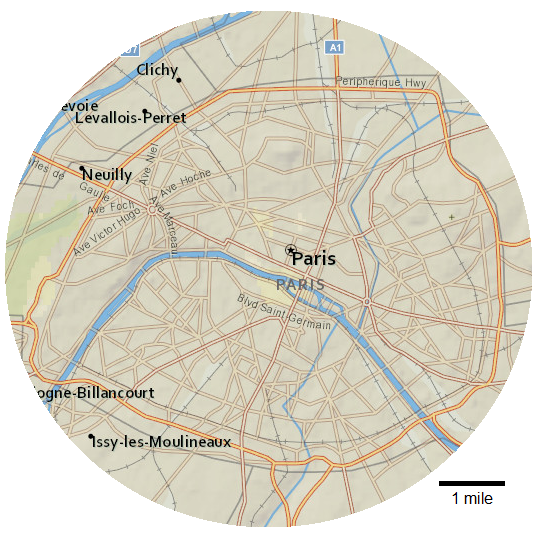Lesson 10
Distinguishing Circumference and Area
Let’s contrast circumference and area.
Problem 1
For each problem, decide whether the circumference of the circle or the area of the circle is most useful for finding a solution. Explain your reasoning.
-
A car’s wheels spin at 1000 revolutions per minute. The diameter of the wheels is 23 inches. You want to know how fast the car is travelling.
-
A circular kitchen table has a diameter of 60 inches. You want to know how much fabric is needed to cover the table top.
-
A circular puzzle is 20 inches in diameter. All of the pieces are about the same size. You want to know about how many pieces there are in the puzzle.
-
You want to know about how long it takes to walk around a circular pond.
Problem 2
The city of Paris, France is completely contained within an almost circular road that goes around the edge. Use the map with its scale to:
-
Estimate the circumference of Paris.
-
Estimate the area of Paris.

Problem 3
Here is a diagram of a softball field:
-
About how long is the fence around the field?
-
About how big is the outfield?

Problem 4
While in math class, Priya and Kiran come up with two ways of thinking about the proportional relationship shown in the table.
| \(x\) | \(y\) |
|---|---|
| 2 | ? |
| 5 | 1750 |
Both students agree that they can solve the equation \(5k = 1750\) to find the constant of proportionality.
- Priya says, “I can solve this equation by dividing 1750 by 5.”
- Kiran says, “I can solve this equation by multiplying 1750 by \(\frac15\).”
- What value of \(k\) would each student get using their own method?
- How are Priya and Kiran's approaches related?
- Explain how each student might approach solving the equation \(\frac23 k=50\).